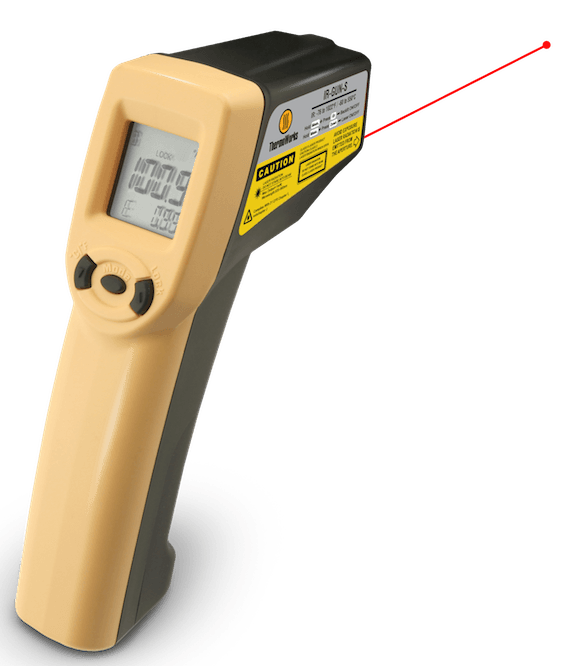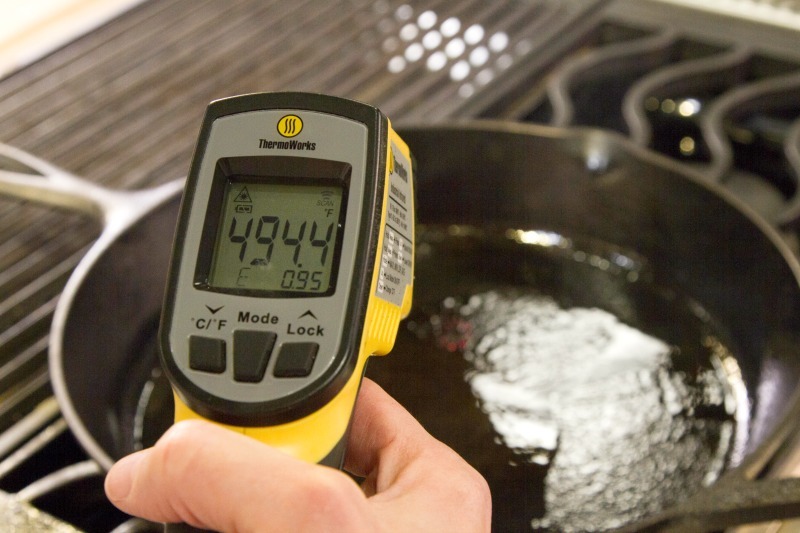Three Common Misconceptions About Infrared Thermometers
Infrared Thermometers

Besides the fact that they’re shaped like a gun and have a built-in laser, infrared thermometers are just plain cool. They’re very fast (instantaneous), provide a good indication of temperature and allow you to collect data at a distance. The problem is, you’ve got to look past the novelty – and learn how to use them properly – before they’ll give you excellent temperature returns.
The first important stipulation is that all ThermoWorks thermometer products except for one are intended for food service, food processing, industrial, scientific and general home use. Our only FDA-cleared thermometer is the WAND™ No Touch Digital Forehead Thermometer. It is an infrared forehead thermometer that uses an algorithm to translate forehead temperatures to oral-temperature equivalents. For more information on using infrared thermometers for health screenings, read this other article with important considerations.
Here are three of the most common misconceptions about infrared thermometers:
#1 The laser reads the temperature
This is just plain wrong. The laser pointer in an infrared thermometer is a guide that indicates where you’re pointing the instrument. When measuring the heat coming from an A/C duct (for example), the laser helps to steady your aim and ensure that you’re close to the area you’re trying to temp.


Depending on the make and model, an infrared thermometer is actually reading the temperature above, below or around where you see the laser. Some infrared thermometers, like the IR Pro Series and the IR-IND are equipped with two lasers. They provide an indication of the infrared radiation being measured between the laser points. And depending on your infrared’s optics, the diameter of the area being measured will change as you get farther away from your target. This is called the optical range.
(Hint: Understanding optical range will greatly improve the accuracy of your temperature measurements. Keep your eyes open for a future post where we’ll take a closer look at what exactly optical range is and how it affects your temperature readings.)
#2 An infrared thermometer will tell you the internal temperature
This is another myth worth busting. An infrared thermometer is a surface temperature tool – period. If you’re grilling, baking, smoking or roasting you’re going to need a penetration probe to tell you the internal temperature of the food you’re cooking. An infrared will only give you the surface temperature of the food, and depending on your optical range, the temp of the surrounding grill, skillet, oven, etc.
Ideally, you would use infrared thermometers to temp the surface of hot oil, a cast iron skillet, a saute pan, even chocolate, and soup. However, whipping out your infrared “laser gun” to temp burgers on the grill may have you explaining to your guests why they’re undercooked.
Forehead thermometers are different, kind of
Medical-use infrared forehead thermometers, like the ThermoWorks WAND™, are for testing internal temperatures, but they do so from the outside. These thermometers use an algorithm to translate the temperature of the forehead—as measured from 1.5″ from the center of the forehead—into an “oral equivalent” temperature reading. This is the exception to the “surface temperature only” rule!
#3 All surfaces are created equal
As a matter of fact, just the opposite is true. Not all surfaces are created equal. Depending on what you’re pointing your infrared gun at you’re likely to get variations in emitted infrared energy. This variation is called emissivity. Emissivity is a measure of a material’s ability to emit infrared energy. It is measured on a scale from just about 0.00 to just below 1.00.

Generally, the closer a material’s emissivity rating is to 1.00 (such as cast iron), the more that material tends to absorb reflected or ambient infrared energy and emit only its own infrared radiation. Most organic materials, including the byproducts of plants and animals, have an emissivity rating of 0.95. These are ideal surfaces for accurate temperature readings.
Substances with very low emissivity ratings, like highly-polished metals, tend to be very reflective of ambient infrared energy and less effective at emitting their own electromagnetic waves. If you were to point an infrared thermometer with fixed emissivity at the side of a stainless steel pot filled with boiling water, for example, you might get a reading closer to 100°F (38°C) than 212°F (100°C). That’s because the shiny metal is better at reflecting the ambient radiation of the room than it is at emitting its own infrared radiation.
What is fixed emissivity?
Fixed emissivity is a setting in some infrared thermometers (usually of 0.95 or 0.97) that attempts to simplify their operation while leaving them suitable for most material surfaces, including almost all foods. Other infrared thermometers come with adjustable emissivity settings, so you can more accurately prepare your thermometer for the type of surface being measured, particularly when measuring non-organic surfaces.



Excellent article. Truly helped me. Thank you so much.
How would emissivity affect readings of a liquid – for example, soup?
Good question! You can’t use an IR to accurately gauge soup because the surface (the only part the IR sees) is constantly experiencing evaporation (cooling) and has some weird, weird boundary conditions. The surface of a soup can be WAY cooler than the inside of a soup. Hot oil is fine, because the oil isn’t evaporating, but water-based liquids are a no go.
It would be extremely helpful if ThermoWorks could publish an emissivity chart of some of the more common surfaces. Such as griddles and pans of various finishes, like the two pans in the picture in the article. What about a house window. Add to the article what effect surface finish (smooth or rough) and color (white to black and all primary colors, paint gloss, satin or flat), etc. have on readings. I found the article answered the myths questions but left me with “but what about …”. These additions would help me use my IR Gun more fully and with greater confidence.
We have one! It doesn’t have everything, but it has a lot. Check it out! https://www.thermoworks.com/emissivity-table/
Fantastic article and explanations. Live and learn.
comes in handy when checking the temp of a baking stone and also for baking steel. I use it on my pizza oven to see if the temp is in the range before placing the dough in the oven
Where does the IR Pro measure relative to the laser dot? I always assumed the reading would be centered around the dot, but the article left me uncertain.
The IR PRO has two lasers, one at the top of the measurement area, one at the bottom. If your IR thermometer has only one laser and it’s from us, that laser is at the bottom of the measurement circle.
In checking the temperature of a very hot environment. Should I leave the thermometer in the room with the items that will be checked in that room? The ambient temp is usually around 130 F.
What difference in temp reading will occur if the thermometer is brought in “cold” or regular room temp?
I have had IR thermometers not work well left at those high heats. They may read “hi” for a time…
Thanks for your time.
If possible, leaving it in the room is a good idea. the lenses through which the IR is read need to acclimate if taken form hot to cold or cold to hot. if you don’t let it acclimate, you will get bad readings. How different or far off it is will depend on the temp swing between the two environments.
I’m not 100% certain how well batteries hold up in that environment, so you may want to even keep batteries in a location scolse to the room but not in it, and just load them in every time…their temp swing won’t matter.